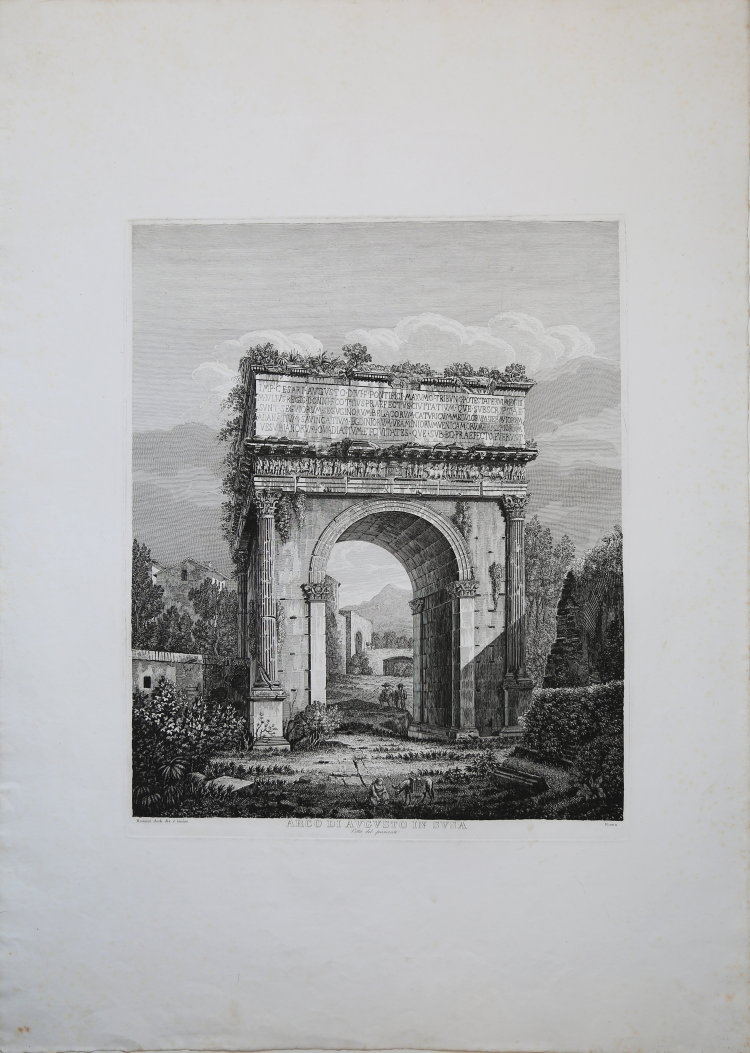



| Reference: | S7552 |
| Author | Luigi ROSSINI |
| Year: | 1836 |
| Zone: | Susa |
| Printed: | Rome |
| Measures: | 360 x 445 mm |


| Reference: | S7552 |
| Author | Luigi ROSSINI |
| Year: | 1836 |
| Zone: | Susa |
| Printed: | Rome |
| Measures: | 360 x 445 mm |
View of the city taken from Gli Archi Trionfali Onorarii e Funebri degli Antichi Romani Sparsi per tutta Italia, printed for the author in 1836.
Luigi Rossini was a master engraver who produced over one thousand plates of buildings, ruins, gardens and monuments. His career coincided with a period of great archeological activity. His etchings of Rome followed Piranesi's example, and reported the latest excavations to an avidly interested European audience. This volume was published as the seventh part of Rossini's grand opus of engravings of ancient Roman antiquities, and concentrates specifically on triumphal and funerary arches. Half of the engravings are exquisite views of the arches themselves, with the remaining plates providing more detailed study of the bas-relief decoration of the arches. All of the major arches in Rome are engraved as well as the magnificent examples in Trieste, Rimini, Fano, Benevento, Aosta, Susa, Perugia, Pola, Carsoli, Spello, Verona, Spoleto, Pompei and Ancona.
Copperplate, in very good conditions. Rare.
Luigi ROSSINI (Ravenna 1790 - Roma 1875)
|
After training at the Academy of Fine Arts in Bologna, where he studied the engraver Francesco Rosaspina and the painter of decorations Antonio Basoli, in 1813 he won the prize of theRegno Italico for architecture, consisting of a board of three years in Rome at Palazzo Venezia, decisive for his artistic career. Here he realized that his attempts to act as architect failed, discovering instead the engravings of Giovanni Battista Piranesi and, through the work of the great Venetian engraver, he is part of the artistic tradition of engraved view. In 1817 Rossini publishes Frontespizio delle antichità di Roma divise in 40 vedute disegnate dal vero dall'architetto Luigi Rossini, that later reprint with the addition of new plates. In those years he also began working with Bartolomeo Pinelli, which will populate the views by Rossini with his distinctive characters. The fruitful relationship between the two artists will continue until the death of Pinelli took place in 1835. Between 1819 and 1823 he engraved, in 101 tables,Le Antichità Romane ossia raccolta delle più interessanti vedute di Roma antica, disegnate ed incise dall'architetto Luigi Rossini. Between 1824 and 1826 Rossini engraved the etchings Le Antichità dei contorni di Roma, and, two years later, publishes I monumenti più interessanti di Roma dal decimo secolo fìno al secolo decimottavo. In 1829 he returns to his favorite themes of antiquity etchings luce Le porte e le mura del recinto di Roma in 35 tavole. In 1837, Rossini was appointed member of theAcademy of Fine Arts of San Luca, which then become academic merit in 1843.
In 1839 he published Viaggio pittoresco da Roma a Napoli in 80 vedute, a sort of modern tourist guide. He died in Rome on 22 April 1875, after an illness that had forced him to bed paralyzed for five years.
|
Luigi ROSSINI (Ravenna 1790 - Roma 1875)
|
After training at the Academy of Fine Arts in Bologna, where he studied the engraver Francesco Rosaspina and the painter of decorations Antonio Basoli, in 1813 he won the prize of theRegno Italico for architecture, consisting of a board of three years in Rome at Palazzo Venezia, decisive for his artistic career. Here he realized that his attempts to act as architect failed, discovering instead the engravings of Giovanni Battista Piranesi and, through the work of the great Venetian engraver, he is part of the artistic tradition of engraved view. In 1817 Rossini publishes Frontespizio delle antichità di Roma divise in 40 vedute disegnate dal vero dall'architetto Luigi Rossini, that later reprint with the addition of new plates. In those years he also began working with Bartolomeo Pinelli, which will populate the views by Rossini with his distinctive characters. The fruitful relationship between the two artists will continue until the death of Pinelli took place in 1835. Between 1819 and 1823 he engraved, in 101 tables,Le Antichità Romane ossia raccolta delle più interessanti vedute di Roma antica, disegnate ed incise dall'architetto Luigi Rossini. Between 1824 and 1826 Rossini engraved the etchings Le Antichità dei contorni di Roma, and, two years later, publishes I monumenti più interessanti di Roma dal decimo secolo fìno al secolo decimottavo. In 1829 he returns to his favorite themes of antiquity etchings luce Le porte e le mura del recinto di Roma in 35 tavole. In 1837, Rossini was appointed member of theAcademy of Fine Arts of San Luca, which then become academic merit in 1843.
In 1839 he published Viaggio pittoresco da Roma a Napoli in 80 vedute, a sort of modern tourist guide. He died in Rome on 22 April 1875, after an illness that had forced him to bed paralyzed for five years.
|